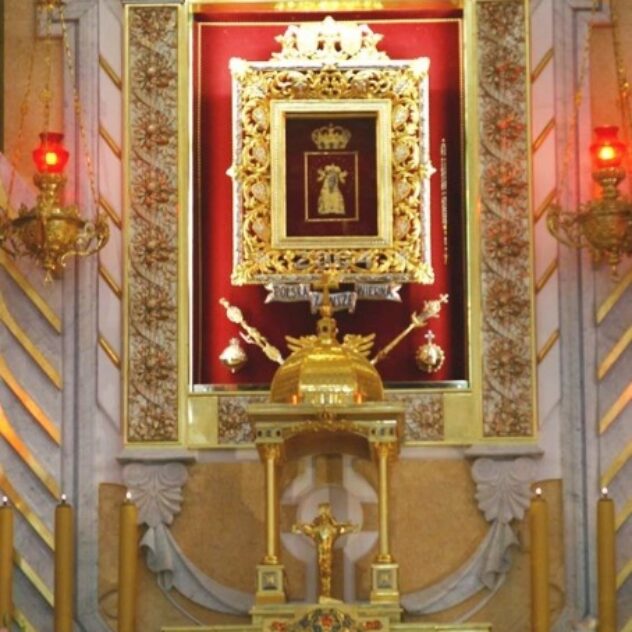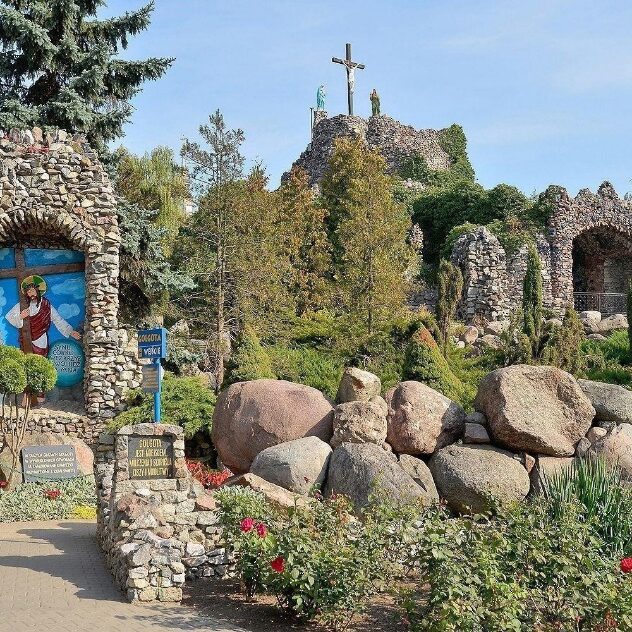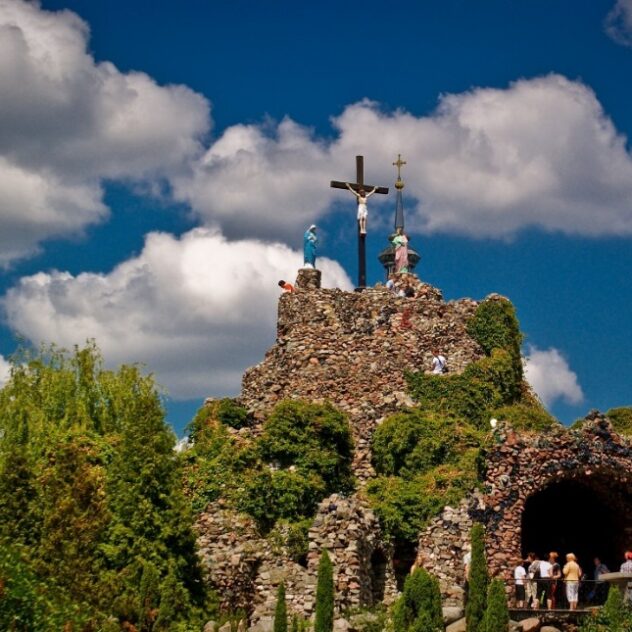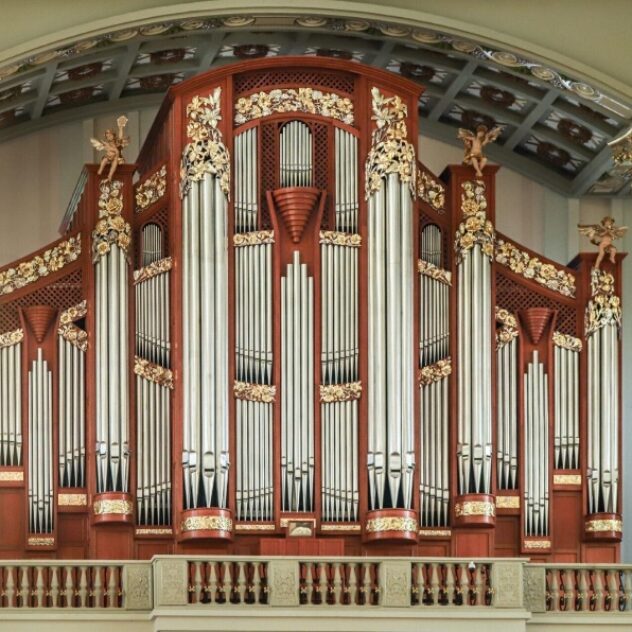The Sanctuary of Our Lady of Lichen, Sorrowful Queen of Poland
Information about the pilgrimage site
The Sanctuary of Our Lady of Licheń is one of the largest and best known in Poland. The origins of the sanctuary date back to the mid-19th century and are connected with the revelations of Our Lady to the shepherd Mikołaj Sikatka. Extraordinary events took place in 1850 in the Grąblin Forest (2 km from Licheń, next to the road to Konin) at the image of Our Lady placed on a pine tree.
During the apparitions, Mary called for prayer, penance and a change of life, and instructed people to collect alms for the propitiatory Masses and to move the painting to a more worthy place. She also warned of an impending cholera epidemic that struck Greater Poland in 1852. The dramatic events reminded the local population of Shepherd Nicholas’ preaching. Shepherd Mikolaj testified under oath about the several sightings to Father Florian Kosinski, the then parish priest of Lichen. The pastor’s report of 5 November 1852 on the extraordinary events, drawn up for the church authorities in Kalisz, is the oldest historical source confirming the fact of the apparitions and reporting on their content.
The testimonies of numerous healings led the church authorities, after investigating the events, to order the transfer of the image to the church in Licheń, which took place solemnly on 29 September 1852.The Church did not officially recognise the apparitions. In 1949, the Lichen parish was taken over by the Congregation of Marian Fathers of the Immaculate Conception of the Blessed Virgin Mary (Latin: Congregatio Clericorum Regularium Marianorum sub titulo Immaculatae Conceptionis Beatissimae Virginis Mariae, abbreviated MIC).
On 15 August 1967, the Primate of Poland, Cardinal Stefan Wyszyński, on the Feast of the Assumption of Our Lady, with the participation of the Ordinary of the Diocese of Wloclawek, Bishop Antoni Pawlowski, many other bishops, several hundred priests, monks and nuns and 150,000 faithful, performed the act of coronation of the image of Our Lady of Lichen. The crown was sent by Pope Paul VI, who gave the image the title Mary – Sorrowful Queen of Poland. Currently, the image is located in the main altar of the new basilica.
In addition to the Miraculous Image, there are other unique places worth seeing and religious and cultural events in Licheń that are worth taking part in.
Tourist attractions in the vicinity
The Church of St. Dorothea in Lichen Stary is a neo-Gothic parish church, which is located within the parish of St. Dorothea run by the Marian Congregation. The church was the main church of the Marian sanctuary in Licheń Stary from 1858 to 2006, and the image of Our Lady of Licheń was kept in the church during this period.
The organ and the Bell of Mary the Mother of God in the Lichen Basilica – the organ is the largest in Poland, the fifth in Europe and the fourteenth in the world. The Bell of Mary the Mother of God – the largest bell in Poland, its weight surpasses that of the Sigismund Bell, the sound of which has been announcing all the most important events in Poland for centuries. The bell in Licheń, together with the basilica, is a votive offering of Poles for 2000 years of Christianity.
Golgotha – is one of the most important places of the Lichen sanctuary. It is an artificially created hill of erratic boulders with chapels, sculptures and figural groups related to the Passion of Jesus Christ. Every pilgrim finds time to wander up the winding path to the summit of Golgotha and stand by the cross to gaze lovingly at the Crucified Christ. It is a place full of reverie and reflection, where one can immerse oneself in spirituality and prayer. Golgotha in Licheń attracts pilgrims from all over Poland and the world who want to worship Christ Crucified.
Rev. Jozef Jarzębowski Museum – located in the back of the Basilica. It has a rich collection of Polish artefacts scattered all over the world: royal documents, old prints, manuscripts by Polish writers, a collection of white weapons from the turn of the 16th to the 20th century. , souvenirs of the independence struggles and from Soviet gulags and Nazi camps. His collection includes oil paintings of sacred subjects from the 17th to the 19th century, as well as engravings by European artists and drawings by Matejko and Kossak. It has one of the largest collections of documents relating to the January Uprising in Poland. From November to the end of April, tours are possible for organised groups by prior arrangement. Web https://www.lichen.pl/muzeum-im-ks-jarzebowskiego/ .
Boulevard Nadwarciański in Konin – is an almost a kilometre-long promenade with viewing terraces, two amphitheatres, a passenger marina, a river marina, walking paths, a recreational meadow with a pond and two wooden footbridges. The Warta River Boulevard in Konin is also one of the points on the route of the Great Loop of Wielkopolska.
Ślesin town square – it is worth taking the time during your trip and stopping for a while at the charming town square in Ślesin. The interesting and long history of this town will certainly interest many visitors. The Napoleon’s Arch, located near the market, is also worth seeing, and the view from the nearby bridge over the lake, beach and beautiful forests is sure to delight many tourists. A cosy market square with a fountain, a statue of a goose trader and the Holy Family – all this makes Ślesin a great place to relax.
Other tourist attractions near the pilgrimage site can be found on the website of the Konin Tourist Information Centre: https://www.turystyka.konin.pl/.
Accommodation
– Accommodation for pilgrims: Pilgrim House “Arka” ( https://arka.lichen.pl/) or Pilgrim House “Bethlehem”, which also has conference facilities for 300 people (https://betlejem.lichen.pl/).
- Other commercial facilities are also available in the area.
Availability
By car
If you are travelling by car, you can reach Licheń via the A2 motorway and then turn onto national road No. 92 in the direction of Poznan. Then turn onto provincial road no. 266 in the direction of Lichen. For those using satellite navigation, simply enter the address of the Sanctuary of Our Lady of Sorrows, Queen of Poland in Licheń, which is easily accessible in most navigation systems. The car park is located near the Sanctuary and the distance from the car park to the main entrance of the Basilica is usually a few hundred metres. This is a convenient option as pilgrims can easily access the Sanctuary on foot after arriving at the car park.
By public transport
There are regular bus services from many cities in Poland, both private and public lines. Passengers can get off at the bus station in Licheń, which is close to the city centre, and from there walk or use local public transport or taxis to the Sanctuary.
For those who prefer to travel by train, it is best to get to a nearby town, such as Konin, and from there take a bus to Licheń. Buses from Konin leave from the bus stop located by the railway station. Their route runs through Aleje 1. Maja, Wyszyńskiego and Jana Pawła II, stopping at all stops along these streets. Outside the administrative boundaries of Konin, the line stops only at the stop in the Grąblin forest, by the Nazareth pilgrimage house. The destination stop in Lichen Stary is located at the car park next to the “Bethlehem” pilgrimage house.
On foot
For those who like to make a pilgrimage on foot, Lichen can be reached via local roads and pilgrimage routes.
On a bicycle
Cyclists can use local roads and pilgrimage routes.









